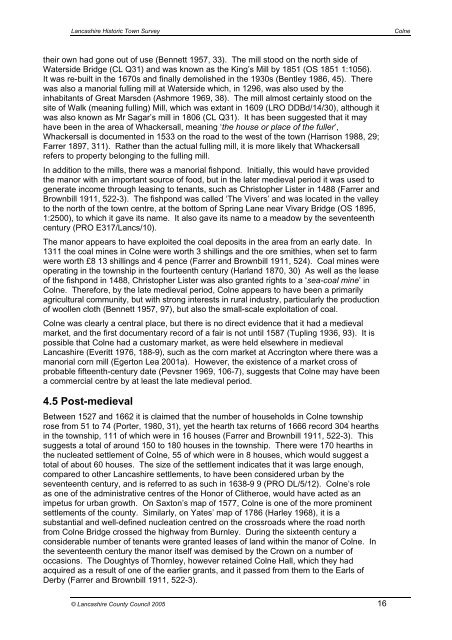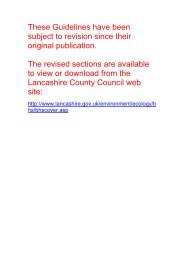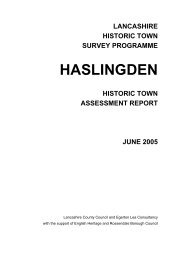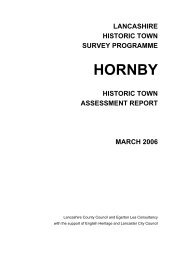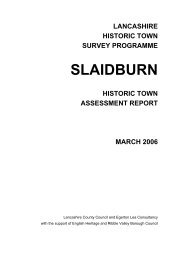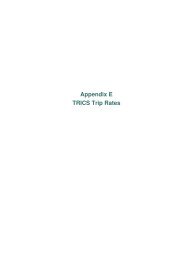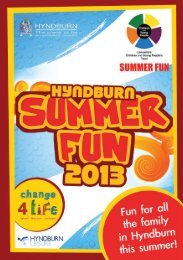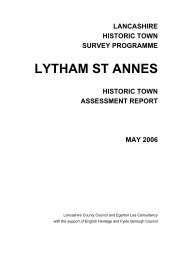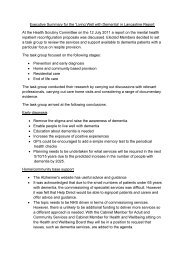Colne - Lancashire County Council
Colne - Lancashire County Council
Colne - Lancashire County Council
Create successful ePaper yourself
Turn your PDF publications into a flip-book with our unique Google optimized e-Paper software.
<strong>Lancashire</strong> Historic Town Survey<strong>Colne</strong>their own had gone out of use (Bennett 1957, 33). The mill stood on the north side ofWaterside Bridge (CL Q31) and was known as the King’s Mill by 1851 (OS 1851 1:1056).It was re-built in the 1670s and finally demolished in the 1930s (Bentley 1986, 45). Therewas also a manorial fulling mill at Waterside which, in 1296, was also used by theinhabitants of Great Marsden (Ashmore 1969, 38). The mill almost certainly stood on thesite of Walk (meaning fulling) Mill, which was extant in 1609 (LRO DDBd/14/30), although itwas also known as Mr Sagar’s mill in 1806 (CL Q31). It has been suggested that it mayhave been in the area of Whackersall, meaning ‘the house or place of the fuller’,Whackersall is documented in 1533 on the road to the west of the town (Harrison 1988, 29;Farrer 1897, 311). Rather than the actual fulling mill, it is more likely that Whackersallrefers to property belonging to the fulling mill.In addition to the mills, there was a manorial fishpond. Initially, this would have providedthe manor with an important source of food, but in the later medieval period it was used togenerate income through leasing to tenants, such as Christopher Lister in 1488 (Farrer andBrownbill 1911, 522-3). The fishpond was called ‘The Vivers’ and was located in the valleyto the north of the town centre, at the bottom of Spring Lane near Vivary Bridge (OS 1895,1:2500), to which it gave its name. It also gave its name to a meadow by the seventeenthcentury (PRO E317/Lancs/10).The manor appears to have exploited the coal deposits in the area from an early date. In1311 the coal mines in <strong>Colne</strong> were worth 3 shillings and the ore smithies, when set to farmwere worth £8 13 shillings and 4 pence (Farrer and Brownbill 1911, 524). Coal mines wereoperating in the township in the fourteenth century (Harland 1870, 30) As well as the leaseof the fishpond in 1488, Christopher Lister was also granted rights to a ‘sea-coal mine’ in<strong>Colne</strong>. Therefore, by the late medieval period, <strong>Colne</strong> appears to have been a primarilyagricultural community, but with strong interests in rural industry, particularly the productionof woollen cloth (Bennett 1957, 97), but also the small-scale exploitation of coal.<strong>Colne</strong> was clearly a central place, but there is no direct evidence that it had a medievalmarket, and the first documentary record of a fair is not until 1587 (Tupling 1936, 93). It ispossible that <strong>Colne</strong> had a customary market, as were held elsewhere in medieval<strong>Lancashire</strong> (Everitt 1976, 188-9), such as the corn market at Accrington where there was amanorial corn mill (Egerton Lea 2001a). However, the existence of a market cross ofprobable fifteenth-century date (Pevsner 1969, 106-7), suggests that <strong>Colne</strong> may have beena commercial centre by at least the late medieval period.4.5 Post-medievalBetween 1527 and 1662 it is claimed that the number of households in <strong>Colne</strong> townshiprose from 51 to 74 (Porter, 1980, 31), yet the hearth tax returns of 1666 record 304 hearthsin the township, 111 of which were in 16 houses (Farrer and Brownbill 1911, 522-3). Thissuggests a total of around 150 to 180 houses in the township. There were 170 hearths inthe nucleated settlement of <strong>Colne</strong>, 55 of which were in 8 houses, which would suggest atotal of about 60 houses. The size of the settlement indicates that it was large enough,compared to other <strong>Lancashire</strong> settlements, to have been considered urban by theseventeenth century, and is referred to as such in 1638-9 9 (PRO DL/5/12). <strong>Colne</strong>’s roleas one of the administrative centres of the Honor of Clitheroe, would have acted as animpetus for urban growth. On Saxton’s map of 1577, <strong>Colne</strong> is one of the more prominentsettlements of the county. Similarly, on Yates’ map of 1786 (Harley 1968), it is asubstantial and well-defined nucleation centred on the crossroads where the road northfrom <strong>Colne</strong> Bridge crossed the highway from Burnley. During the sixteenth century aconsiderable number of tenants were granted leases of land within the manor of <strong>Colne</strong>. Inthe seventeenth century the manor itself was demised by the Crown on a number ofoccasions. The Doughtys of Thornley, however retained <strong>Colne</strong> Hall, which they hadacquired as a result of one of the earlier grants, and it passed from them to the Earls ofDerby (Farrer and Brownbill 1911, 522-3).© <strong>Lancashire</strong> <strong>County</strong> <strong>Council</strong> 2005 16


